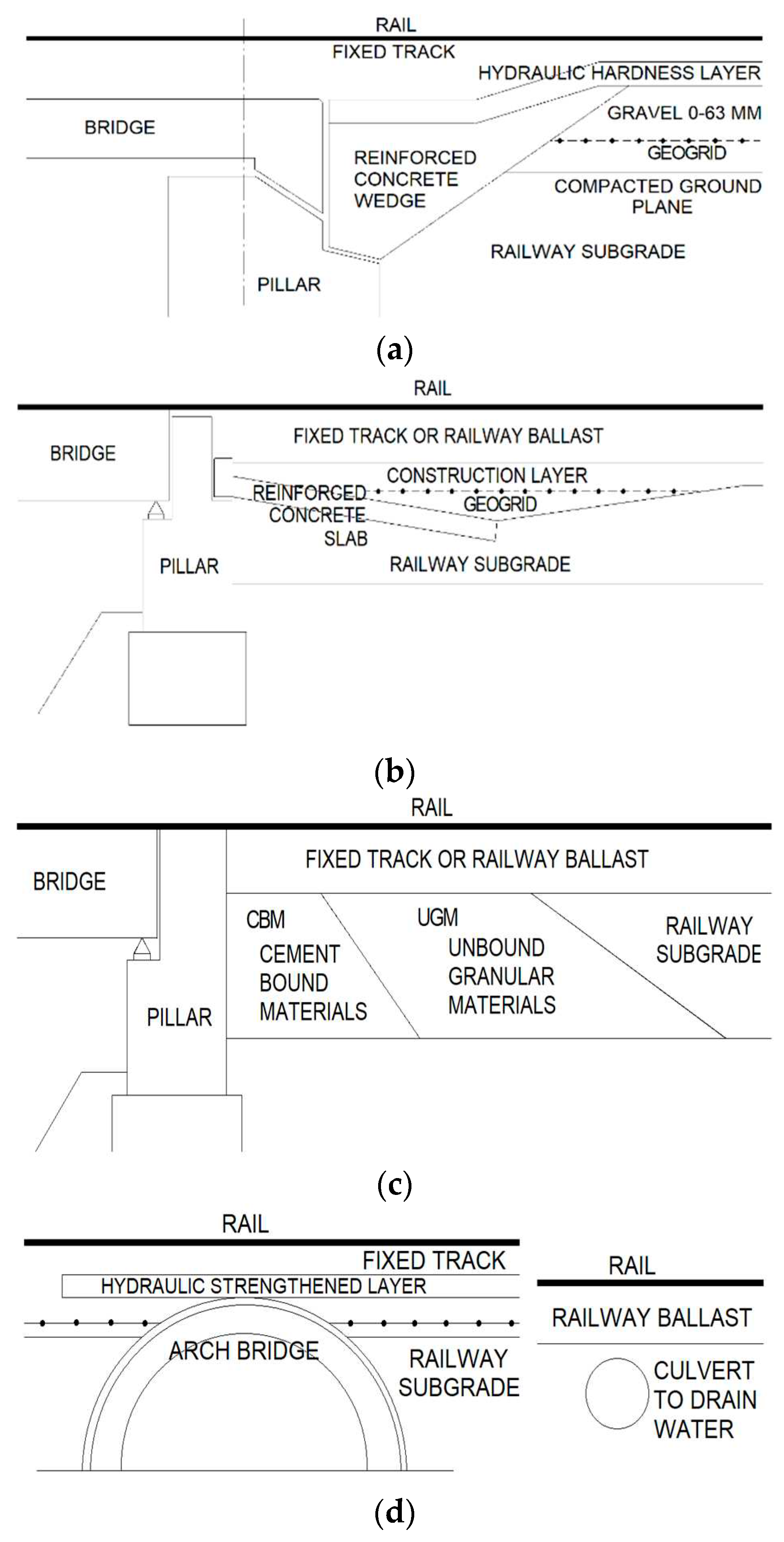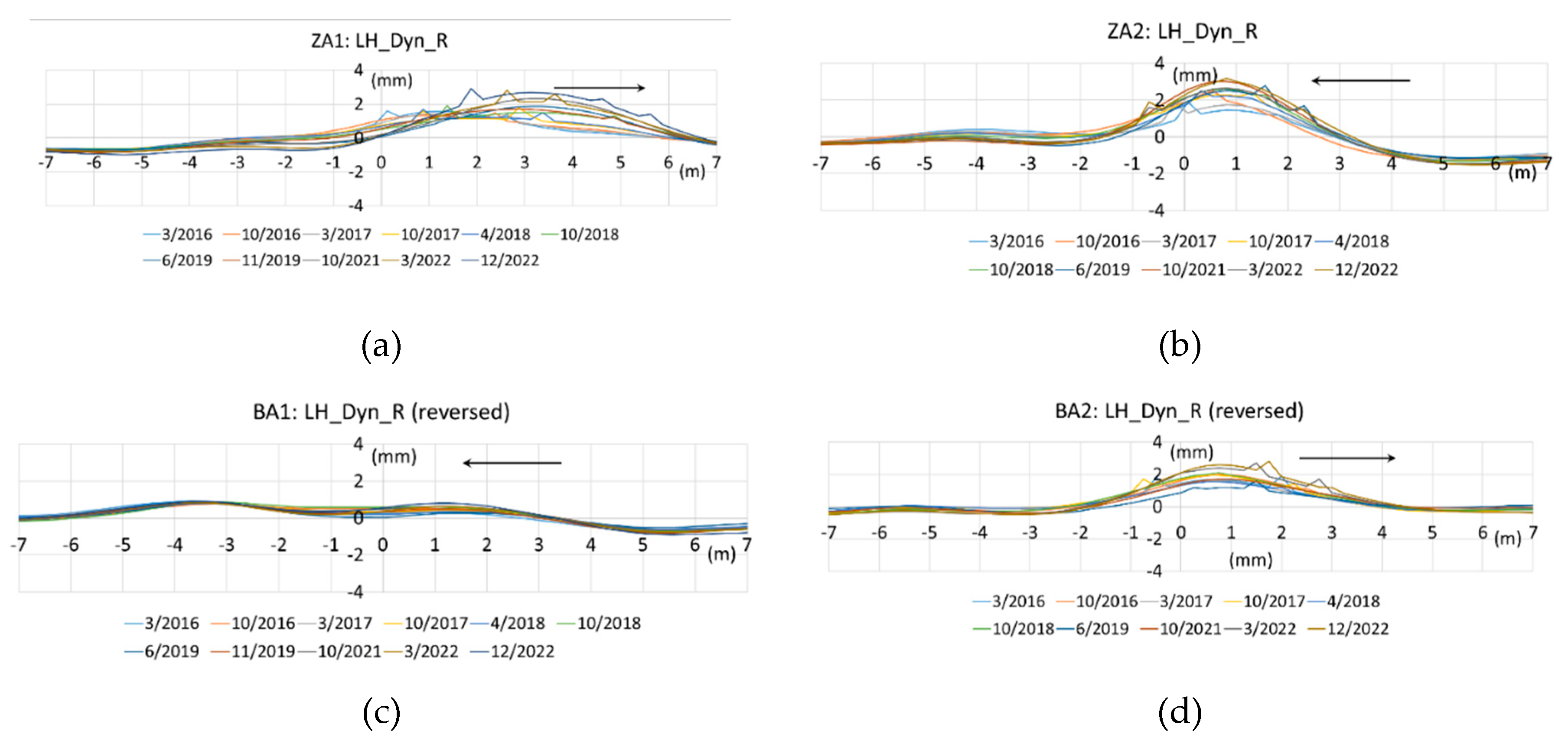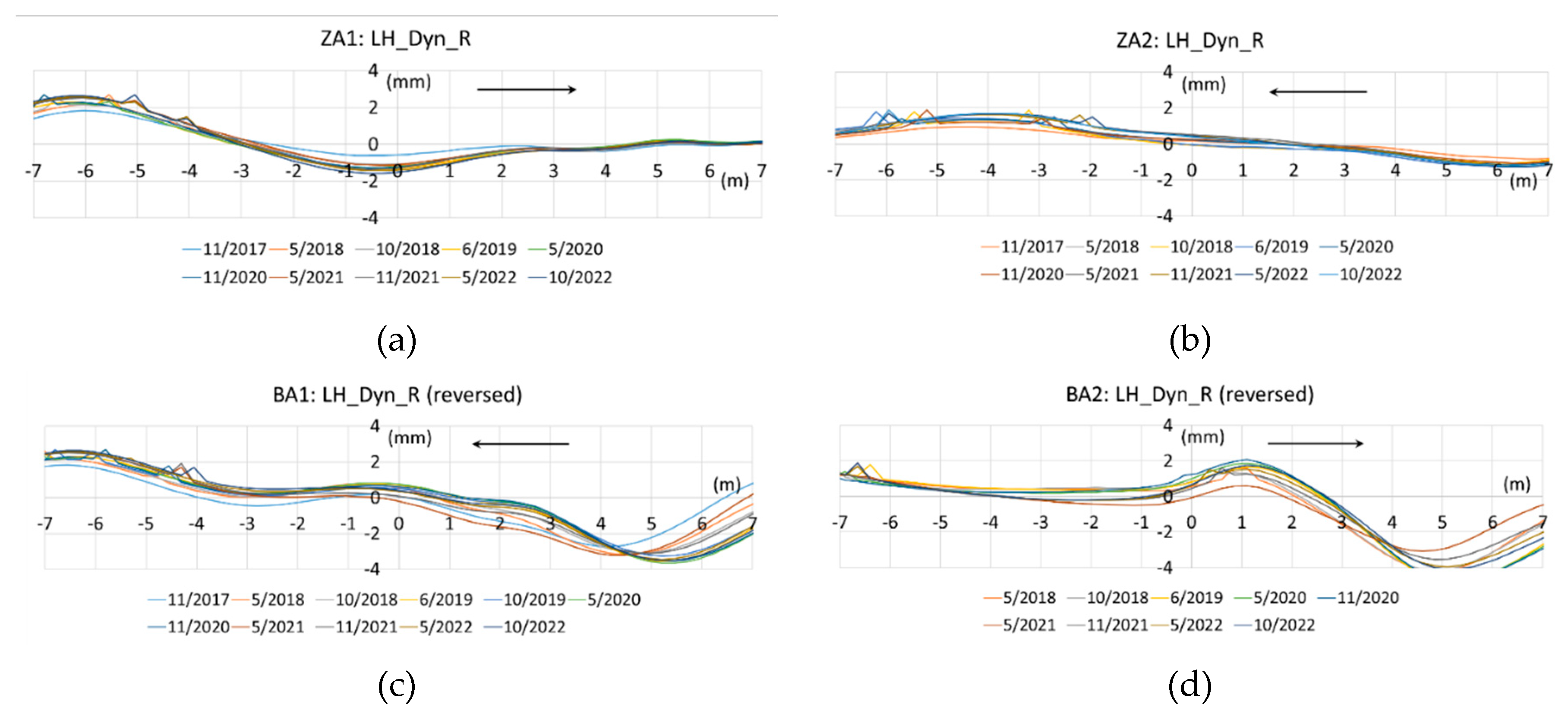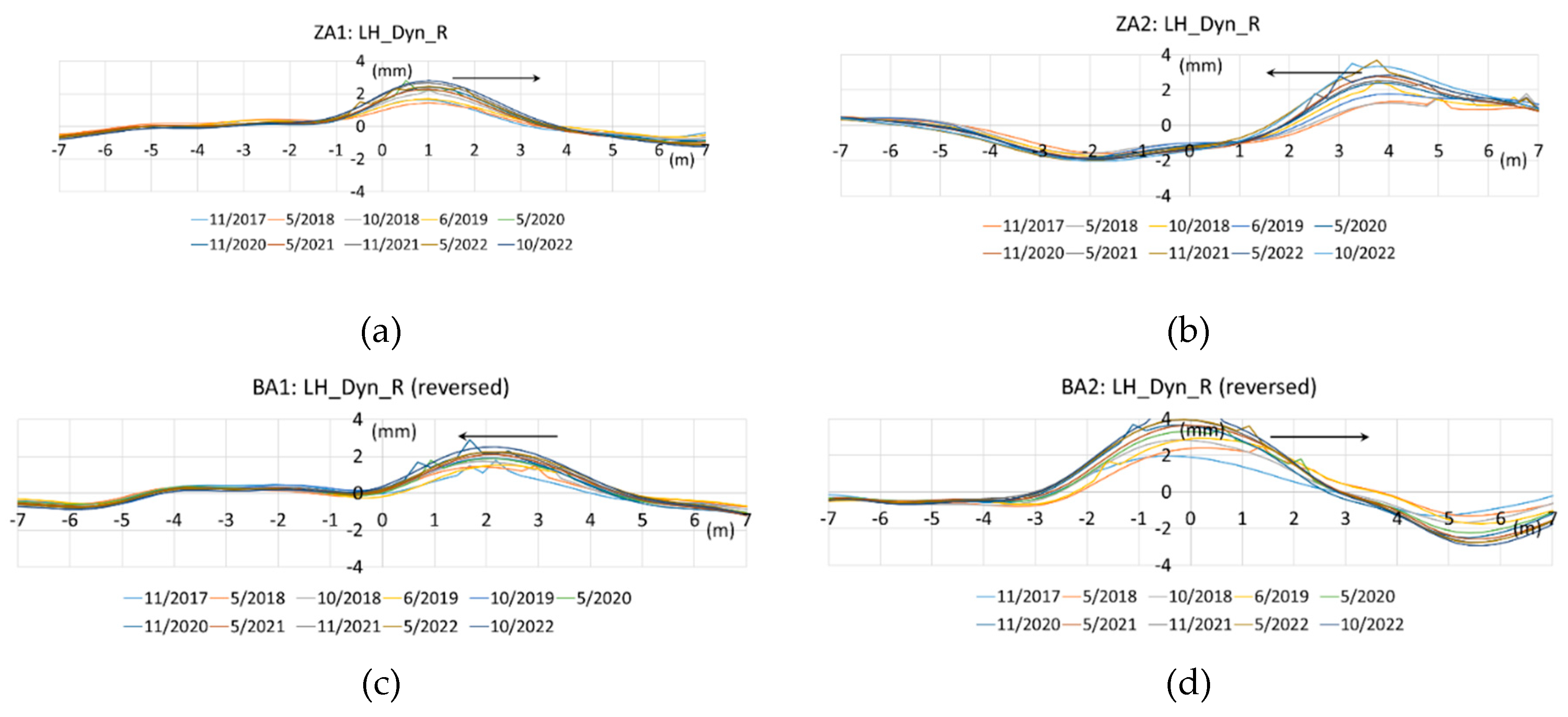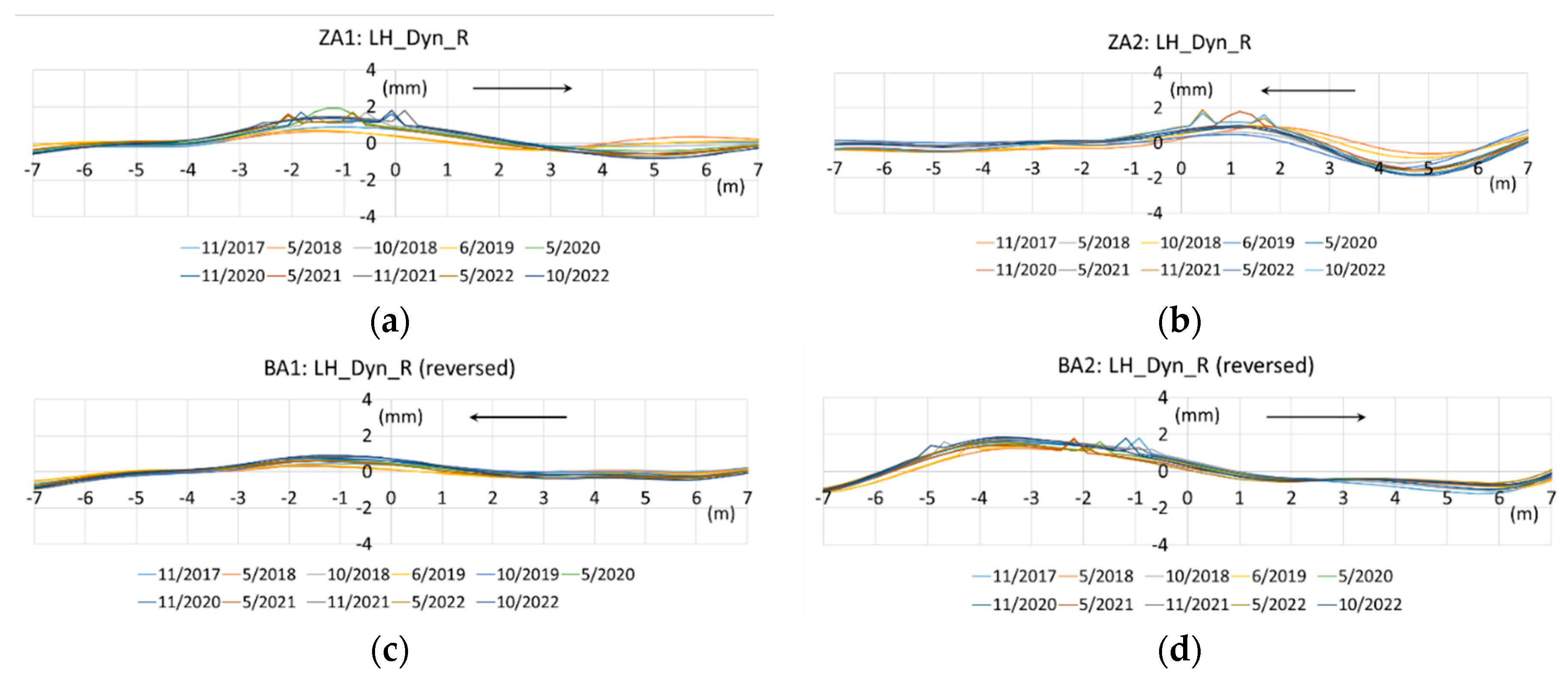1. Introduction
Scientific expertise monitors the state of the geometric position of the track (GPT) in the operated transition zones applied in the framework of the modernization of international railway corridors. Part of these lines are the so-called "transition zones" (TZ), i.e. sections with different stiffness of the track (sudden change of structural materials), such as the transition between a fixed track and a classic track bed, and also these structures in the locations of bridge supports and their pillars, tunnel portals, structures of railway sub-structure, etc.
The issue of transition zones is very topical in the conditions of the Slovak Railways (SR). The results of monitoring and expertise indicate that their structural modification is necessary so that these locations do not cause height fluctuations of rolling stock when the stiffness of the structural materials of the railway superstructure and substructure, including structural layers and objects built into the railway track, changes.
As part of the monitoring and expert investigation, documents will be prepared for future research tasks in order to solve this problem. The problem of transition zones in locations of "step" changes in the stiffness of the railway and also the dynamic action of rolling stock lead to disturbances in quality, i.e. safety and even the service life of the track.
Realization of in-situ measurements in the track for the long-term period 2013-2022 (in this contribution, the beginning of the evaluation was determined from 2016) of selected sections by continuous measurements with diagnostic measuring devices KRAB [
1] with the methodology used at Railways of Slovak Republic (ZSR), concludes that there are shock waves in these locations and there is a disturbance, for example, of the height course of GPT.
2. Current status – transition zones
The International Federation of Railways UIC prefers rail transport as a carrier in terms of ecology, safety and track speed, transported persons and goods (new construction V ≥ 250 km/h, reconstruction V ≥ 160 km/h), while in Slovakia modernization is underway at V = 160 km/h. For this reason, this issue of transition zones is required in the Railways of SR.
All test sections for the purpose of monitoring and research activities were established on the trans-European corridor “Va” with the aim of obtaining a comprehensive evaluation from the point of view of the impact on the track in these locations.
The mentioned problem is also solved on foreign railways, and these experiences must also be incorporated into the conditions on the ZSR lines. Transition zones were also addressed by foreign researchers such as Heydari-Noghabi, H.; Zakeri, JA.; Esmaeili, M.; Varandas, JN. [
2] using additional rails and an approach slab. High-speed lines depending on the train speeds were part of the dynamic characteristics for a fixed reinforced concrete track published by authors Park, S.; Kim, JY.; Kim, J.; Lee, S.; Cho, KH. [
3]. The area of transition zones near bridge objects is addressed in Paixao, A.; Fortunato, E.; Calcada, R. [
4] as in-situ measurements and numerical modeling. Another solution can be seen in Shan, Y.; Albers, B.; Savidis, SA. [
5], where the authors deal with the dynamic processes in the transition zones in the layers and objects of the subgrade of the railway line. In the research of Mottahed, J.; Zakeri, JA.; Mohammadzadeh, S. A. [
6] the transition from the classic track bed to bridge objects is solved using USPs effects. Numerical analysis of railway bed layers was presented by Zuada Coelho, B.; Hicks, M. [
7]. Authors Fortunato E.; Paixao A; Calcada R. [
8] propose a railway track in the area of transition zones within its analysis, monitoring, and numerical modeling. The dynamic responses of the transition zones of the high-speed railway, as part of the solution of the lower structural layers, are elaborated in Hu, P.; Zhang, Ch.; Wen, S.; Wang, Y [
9]. The problem of the dynamic behavior of railway lines in the area of transition zones was dealt with by the authors Varandas, JN.; Holscher, P.; Silva, MAG. [
10]. A substantial part was devoted to the issue by Le, THM.; Lee, TW.; Seo, JW.; Park, DW. in the experimental investigation and numerical analysis of materials in structural layers for railway bridges [
11]. The methodology of the complex analysis of railway transition zones is solved by authors Wang, H.; Markine, V. [
12].
It can be concluded that these are authors with a significant relationship of attention to the issue of the design of railway tracks within transition zones. With the same intention, the results of monitoring and expertise activities at the Department of Railway Engineering (DRE) of the Faculty of Civil Engineering of the University of Zilina are also presented [
13,
14,
15,
16].
3. Bridge objects as transition zones
It is assumed that the experimental measurements of 2016-2022 provided a sufficient basis for future research tasks aimed at increasing the stiffness of the railway track in the area of its sudden change (sudden change of materials used in the profile of the railway line). For this purpose, several test sections of transition zones were monitored and ex-pertly examined in-situ at bridge supports with the aim of obtaining a comprehensive view of how they affect the rail track, i.e. geometric position of the track (GPT).
For this purpose, several railway sections were monitored: transition from gravel-free to gravel structure of the railway superstructure (this is the subject of other publications), transition in the location between the track and bridge supports (large and small span, including drainages), the transition between the track and tunnel portals, etc. The main research activities took place in the section with a fixed track near the "Turecky Vrch" railway tunnel near Trencianske Bohuslavice village (tunnel, two bridges, and drainage), and the presented results are also from the section near the double-track railway bridge over the Vah river in the city of Trencin (3 bridges). All sections are part of the European Corridor.
It was found that in these transition zones, there are various types of structures to mitigate the effects of impacts from train wheels (reinforced concrete wedges and slabs, structural layers of various types of materials, geo-materials, etc. according to
Figure 1 and
Figure 2a).
Experimental measurements and in-situ inspection of transition zones took place as part of the research tasks of the Department of Railway Engineering (DRE) in the village of Trencianske Bohuslavice in 2013 and in the town of Trencin in 2016. The paper presents the results of this monitoring from 2016 and 2017, respectively, in places where the height change of the height wave is most pronounced in the gradients of the railway track, which is caused by the arrangement of materials of different stiffness in the track. Research activities were addressed by the final outputs in Hodas, S. et al. [
13,
14], and within the VEGA projects [
16] in recent years.
The new resulting measured values are presented for the purpose of future research of the DRE department within the modification of these structural parts in transition zones, for the purpose of removing height waves when trains are running (or minimizing them).
4. Methods – long-term monitoring in the track
Long-term monitoring of both rail strings (R/L) in each track (No. 1, No. 2) revealed the course of their height curves, i.e. deformation of the level at this “jump” point in the transition zone. The paper presents the R curves. The curves of the second rail belt L are located at the authors’ workplace, they have a similar course, or they differ only minimally. Near the village of Trencianske Bohuslavice, monitoring was carried out in the transition zones at the supports of two small bridge structures with spans 25 m and 15 m in
Figure 3 and
Figure 4, and one drainage in
Figure 5. In the town of Trencin, monitoring measurements were carried out on a long bridge with a span of 340 m over the river Vah in
Figure 7 including its pillars No. 3 and No. 5 in
Figure 8, and two small bridges with a bridge length of spans 12.5 m and 18 m in
Figure 6 and
Figure 9.
Expertise measurements were performed continuously with a KRAB measuring cart [
1] with a recording step of 250 mm. The values obtained by in-situ measurements will be the basis for subsequent scientific projects, for example, VEGA 2024-2026 [
17] (submitted in the approval process), where optimized proposals for numerical modeling of transition zones will be created. The purpose is to eliminate, or minimize, the height changes of the GPT level, arising as a deformation of the track during the movement of train sets through the transition zones, in this case just before and behind the bridges. The selection of treatment of materials with higher stiffness is considered comprehensively, including the railway superstructure and substructure in the transition zone at the support of the bridge object with the use of meters of forces acting between their individual structural parts.
The complexity of the solution for the relevant final outputs in order to meet the future goals of the projects must be ensured by choosing suitable representative locations in-situ in the track, i.e. test sections.
5. Discussion – inspection results and evaluation of expertise measurements
Objects of transition zones were measured and systematically processed under the same conditions. The selection of research sections was carried out in each rail (No. 1, No. 2), i.e. two transition zones in the direction of Zilina town (ZA1 and ZA2) and 2 transition zones in the direction of Bratislava town (BA1 and BA2). The number means the track number No. 1 and No. 2 according to
Figure 2.
As can be seen from
Figure 2, the figures of TZ as
Figure 3,
Figure 4,
Figure 5,
Figure 6,
Figure 7,
Figure 8 and
Figure 9 are turned with its solid part and gravel part once towards the ZA and once towards the BA. In order to be perceived as the same "step" from hard to soft material (movement from the bridge abutment to the fixed track or gravel bed), transition zones BA1 and BA2 are reversed to the opposite direction of run for the purpose of their uniform evaluation. The arrow in the pictures shows the prevailing direction of the train run (→, 70 % to 90 %).
On all sections according to
Figure 3,
Figure 4,
Figure 5,
Figure 6,
Figure 7,
Figure 8 and
Figure 9 is a proven "step" with subsequent pushing of material with lower stiffness (for example, track bed, lower layers, reinforced concrete transition plate, etc.) with subsequent pushing it out and raising the gradient, i.e. an unwanted height wave is created. In the images with the highest wave height, in
Figure 3b,
Figure 4b,c,d,
Figure 5a,
Figure 6c,d,
Figure 7a-d and
Figure 8b, it was found within the framework of long-term measurements 2016-2023 that it is necessary to increase the stiffness of objects and structural layers by future modeling. On the basis of the established fact, it is necessary to proceed with the design work to secure these locations already during their design itself (adjust the thickness of the layers, exchange of materials, additional structures of the railway superstructure and substructure, etc.).
The final results are drawn up in
Figure 3,
Figure 4,
Figure 5,
Figure 6,
Figure 7,
Figure 8 and
Figure 9. New reinforced concrete wedges, slabs, or blocks at the supports of bridge objects also play a big role, as a result of which these maximums and minimums of height waves can be moved beyond these built-in block objects. Some of these transition zones are located on high railway embankments of 4-12 m, and the subgrade of the railway substructure can also be deformed. Others are located on the rocky bed
Figure 3c,
Figure 6b, or are the pillars of the long bridge
Figure 8a-d.
5.1. Experimental sections: Trencianske Bohuslavice
Each subsequent experimental measurement confirmed the height deformation from previous periods. The BRIDGE 1 structure is located near the tunnel above the river,
Figure 3 shows the height changes within the measurements of continuous deflections, but
Figure 3c (BA1) is not found, as it is assumed that this transition zone in track No. 1 has a stable subgrade. On this bridge, there are reinforced concrete structural blocks in front of the bridge.
The second BRIDGE 2 is located on a high embankment of 5-8 m, in
Figure 4a (ZA1) the railway is stable in height. In other parts, there is extruded material in
Figure 4b,d, but most of it is a "step" in
Figure 4c (transition zone BA1).
In this part of the section, there is a pipe DRAINAGE 1 in
Figure 5, where a classic track bed is designed, which is tamped by automatic tamping machines at a certain time interval (or if there are height deviations exceeding the permitted deviations during operation), and in this case, it is bedrock.
5.2. Experimental sections: Trencin
Figure 6 is a vaulted BRIDGE 1 with a small span of approx. 12.6 m, where the structure parts are not modified as transition zones, only the consolidated layer according to
Figure 1d. In terms of height, the gradient of the tracks is divided.
VAH BRIDGE of large span with pillars in the river Vah in
Figure 7 contains the adjustment of transition zones with reinforced concrete (RC) wedges approx. 6 m with a height of 1.8 m according to
Figure 1a. In the transition zones, the material is pushed out behind these RC wedges. In all 4 cases of this bridge object, adjustment of transition zones is necessary for future proposals for new projects or for the reconstruction and modernization of railway lines. On the pillars of this long bridge shown in
Figure 8, height deformations do not occur (relative relationship – fixed track on pillars and no subgrade, except foundations).
BRIDGE 2 in
Figure 9 has proven smaller height waves approx. ≤ 2 mm, this is also a fixed track.
6. Conclusions
The transition zones, in this case at the supports of bridge structures, must be designed in such a way that they achieve not only optimal stiffness grading for real operating loads but also use new progressive structural materials and elements. In some cases, it will not be possible to insert a new element into the structure, for example, thicker pads (2-4 mm to reduce the dynamic load) of the rail, since it is a concrete slab of a fixed rail and there would be an increase in the gradient of the rail at this critical point in the transition zones (acute sections at the point of stiffness jump). But it is possible to implement them in the transition zone, where there is a gravel bed because it is possible to change the height elements without changing the gradient of the track. Other elements can be changed, including the addition of new supporting structures, or the replacement of layers of materials with a change in their height, i.e. it is necessary to pay attention to the lower structure of the subgrade.
From the images from
Figure 3 to
Figure 9, it follows that the height difference mainly arises from the compression and pushing of structural layers and materials in the railway substructure. The railway superstructure can be strengthened with additional rail belts, stiffer clamps, etc., but if the railway substructure or subgrade declines, this will also be reflected in the height change of the track geometry – gradient shortly after the track is put into operation, in our case the transition zones.
From the point of view of the transition zone, the expected benefit will be the differentiation of structural materials and elements and their effects on achieving an optimal gradation of the stiffness of the railway between places with different stiffness, i.e. bridge transition zones occur on every railway line.
After the analysis of the experimentally measured sections in situ, it is concluded that undesirable errors and deficiencies in the geometry of the track, especially its height changes, arise as a result, and it is necessary to identify and eliminate them already during the design or during the new modernization of these sections on the railway line [
17]. Otherwise, their height adjustment will be necessary during the entire period of operation of these objects, and this is an unnecessary additional financial cost.
Author Contributions
Conceptualization, S.H. and E.V.; methodology, S.H.; software, S.H. and E.V; validation, S.H., A.P.; formal analysis, S.H.; investigation, S.H. and A.P.; resources, S.H. and E.V.; data curation, S.H.; writing—original draft preparation, S.H. and A.P.; writing—review and editing, S.H. and A.P; visualization, S.H.; supervision, S.H. and E.V.; project administration, S.H.; and A.P; funding acquisition, S.H. All authors have read and agreed to the published version of the manuscript.
Funding
This research received no external funding.
Acknowledgments
The presented parts of the paper were created within the framework of the research activities VEGA 1/0084/20 [16] by the Department of Railway Engineering at the Faculty of Civil Engineering of the University of Zilina (FCE-UNIZA). The authors would like to thank the Editor and Reviewers for their constructive comments and valuable suggestions to improve the quality of the article.
Conflicts of Interest
The authors declare no conflict of interest.
References
- KRAB. KZV – Commercial Railway Research. 2021. Available online: S-light EN.indd(kzv.cz) (accessed on 12 June 2023).
- Heydari-Noghabi, H.; Zakeri, J.A.; Esmaeili, M.; Varandas, J.N. Field study using additional rails and an approach slab as a transition zone from slab track to the ballasted track, Proceedings of the Institution of Mechanical Engineering Part F-Journal of Rail and Rapid Transit; 2018, 232(4), 970-978. (accessed on 5 May 2023). [CrossRef]
- Park, S.; Kim, J.Y.; Kim, J.; Lee, S.; Cho, K.H. Analysis of Dynamic Characteristics of Deformed Concrete Slab Track on Transition Zone in High-Speed Train Line According to Train Speeds, Applied Sciences. 2020, 10(20), 7174. (accessed on 10 April 2023). [CrossRef]
- Paixao, A.; Fortunato, E.; Calcada, R. Transition zones to railway bridges: Track measurements and numerical modelling, Engineering Structures. 2014, 80, 435-443. (accessed on 2 May 2023). [CrossRef]
- Shan, Y.; Albers, B.; Savidis, S.A. Influence of different transition zones on the dynamic response of track-subgrade systems, Computers and Geotechnics. 2013, 48, 21-28. (accessed on 7 March 2023). [CrossRef]
- Mottahed, J.; Zakeri, J.A.; Mohammadzadeh, S.A. Field Investigation on the Effects of Using USPs in Transition Zone From Ballasted Track to Bridges, International Journal of Civil Engineering. 2019, 17(9A), 1421-1431. (accessed on 29 April 2023). [CrossRef]
- Zuada Coelho, B.; Hicks, M. Numerical analysis of railway transition zones in soft soil. Proceedings of the Institution of Mechanical Engineers, Part F: Journal of Rail and Rapid Transit. 2016, 230(6), 1601-1613. (accessed on 27 March 2023). [CrossRef]
- Fortunato E.; Paixao A; Calcada R. Railway track transition zones: design, construction, monitoring, and numerical modeling, International Journal of Railway Technology. 2013, 2(4): pp. 33–58. Available online: Railway track transition zones: design, construction, monitoring, and numerical modeling - researchgate.net (accessed on 28 April 2023). [CrossRef]
- Hu, P.; Zhang, Ch.; Wen, S.; Wang, Y. Dynamic responses of high-speed railway transition zone with various subgrade fillings. Computers and Geotechnics. 2019, 108, 17–26. (accessed on 12 January 2023). [Google Scholar] [CrossRef]
- Varandas, J.N.; Holscher, P.; Silva, M.A.G. Dynamic behavior of railway tracks on transitions zones, Computers and Structures. 2011, 89(13-14), 1468-1479. (accessed on 19 May 2023). [CrossRef]
- Le, T.H.M.; Lee, T.W.; Seo, J.W.; Park, D.W. Experimental investigation and numerical analysis on the performance of flowable soil as feasible backfill material for railway bridge approach, Transportation Geotechnics. 2021, 28, 100542. (accessed on 31 March 2023). [CrossRef]
- Wang, H.; Markine, V. Methodology for the comprehensive analysis of railway transition zones. Computers and Geotechnics. 2018, 99, 64–79. (accessed on 29 May 2023). [Google Scholar] [CrossRef]
- Hodas, S.; Izvoltova, J.; Chromcak, J.; Bacova, D. Monitoring the Geometric Position of Transition Zones to Increase the Quality and Safety of Railway Lines, Applied Sciences. 2022, 12(12), 6038. (accessed on 10 February 2023). [CrossRef]
- Hodas, S. ; Pultznerova, A; Izvoltova, J. Protection of Structural Layers of Transitions Zones on Railways against Freezing, Using Materials with a Low Coefficient of Thermal Conductivity. Buildings. 2022, 12(6), 821. (accessed on 23 March 2023). [CrossRef]
- Izvolt, L.; Dobes, P; Drusa, M.; Kadela, M.; Holesova, M. Experimental and numerical verification of the railway track substructure with innovative thermal insulation materials. Materials. 2022, 15(1), 160. (accessed on 16 January 2023). [CrossRef]
- Izvolt, L. et al. VEGA 1/0084/20. Numerical and experimental analysis of transition zones of objects of structures of railway superstructures and objects of formation substructure. Scientific research, Dept. of Railway Engineering, Faculty of Civil Engineering, University of Zilina, Zilina, http://svf.uniza.sk/kzsth, VEGA - Ministry of Education. Science and research of the Slovak Republic, Bratislava, Slovakia; 2020-2023. 2020, Available from < http://www.minedu.sk/about-the-ministry/ >.
- Hodas, S. et al. VEGA 1/0246/24. Experimental and numerical analysis, diagnosis, and modification of structural parts of transition zones of railway tracks. Submitted new scientific research in the evaluation process, Dept. of Railway Engineering, Faculty of Civil Engineering, University of Zilina, Zilina, http://svf.uniza.sk/kzsth, VEGA - Ministry of Education. Science and research of the Slovak Republic, Bratislava, Slovakia; 2024-2026. 2023, Available from < http://www.minedu.sk/about-the-ministry/ >.
|
Disclaimer/Publisher’s Note: The statements, opinions and data contained in all publications are solely those of the individual author(s) and contributor(s) and not of MDPI and/or the editor(s). MDPI and/or the editor(s) disclaim responsibility for any injury to people or property resulting from any ideas, methods, instructions or products referred to in the content. |
© 2023 by the authors. Licensee MDPI, Basel, Switzerland. This article is an open access article distributed under the terms and conditions of the Creative Commons Attribution (CC BY) license (https://creativecommons.org/licenses/by/4.0/).
